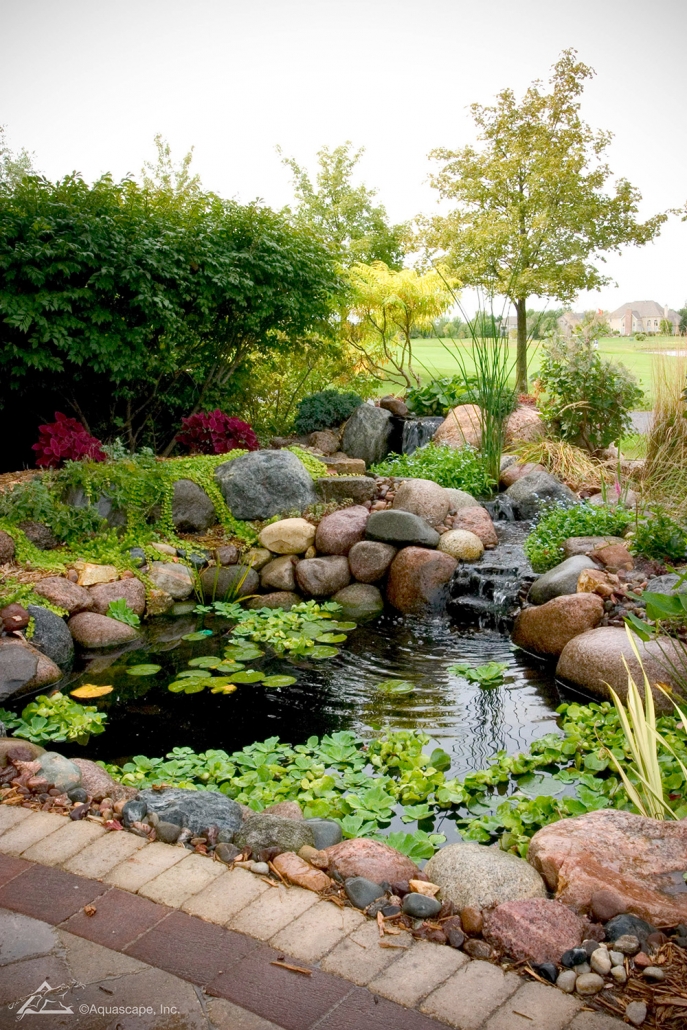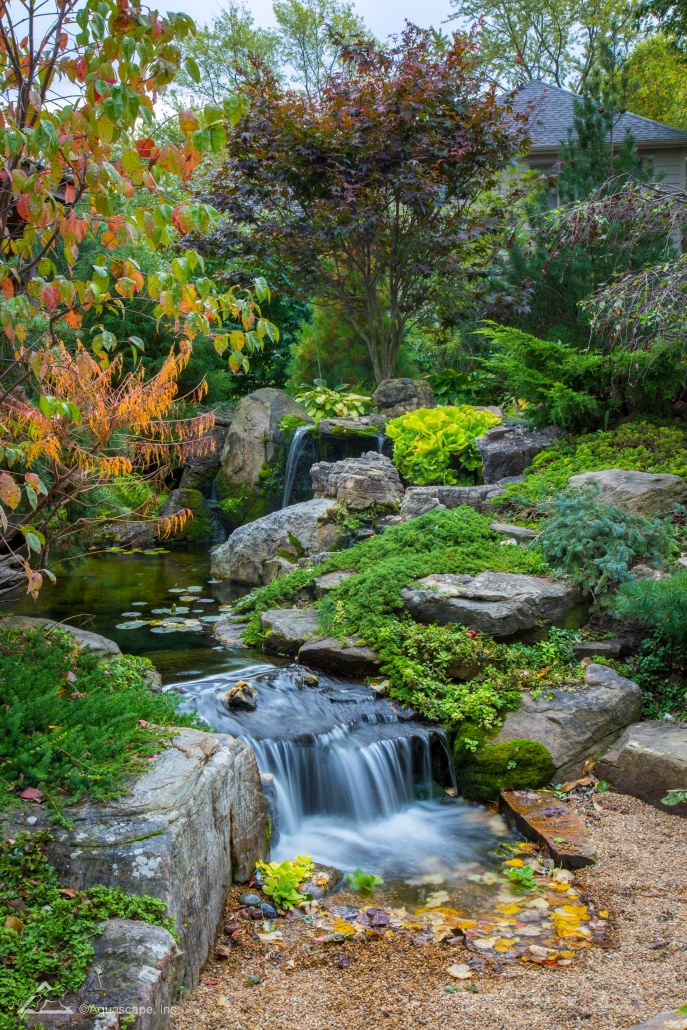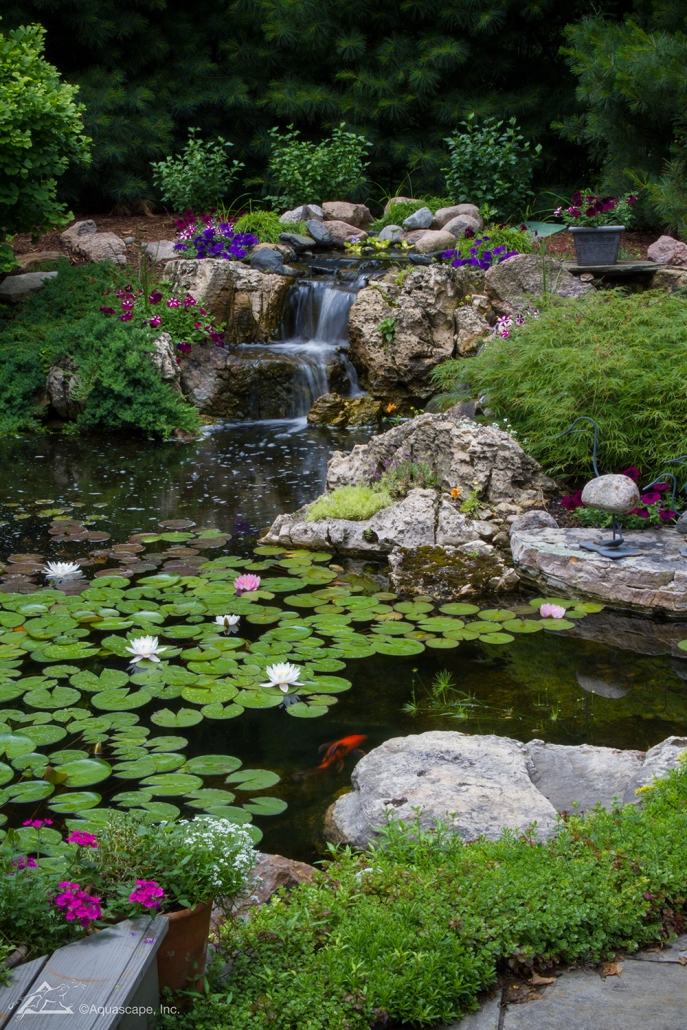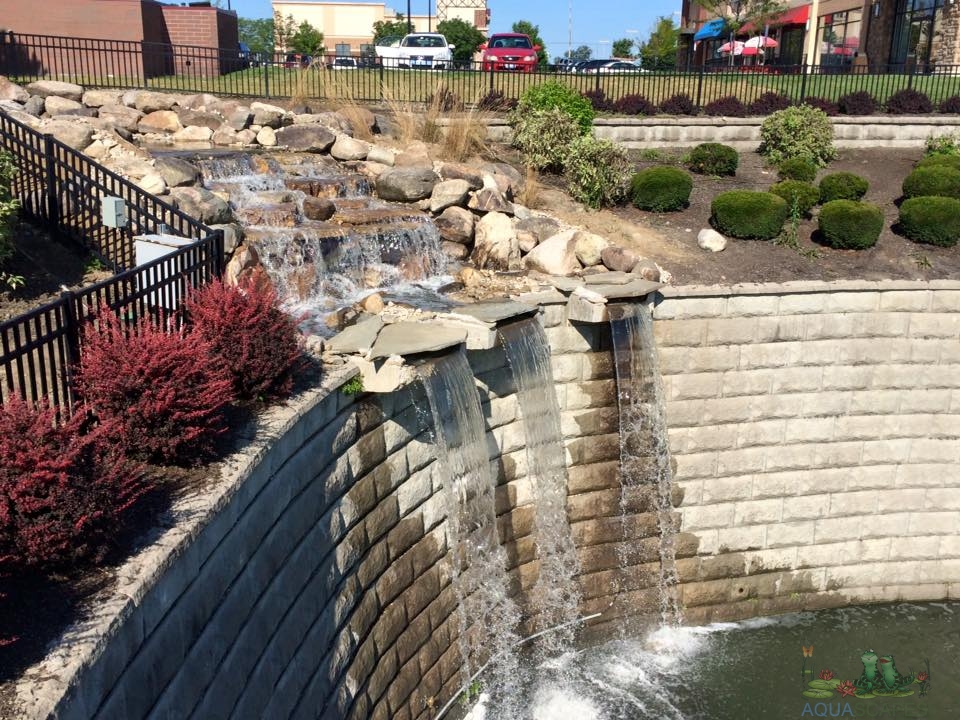How Long Does a Pond Pump Need to Be on Each Day?
A pond pump and a filter are necessary to maintain pond health. A well-maintained pond adds value to a home, and even though a large pond with fish requires more maintenance than a small pond, it is worth the extra effort, providing movement, color and a dramatic landscape element. A pond’s pump should run 24 hours each day to ensure the pond’s water circulates through the filter to keep the water clear.
Pump Function
A pond pump may be submerged in the pond’s water or sit outside the pond, depending on the pump type, but both types work in the same way. The pump uses spinning blades, known as impellers, to pull pond water through a screenlike intake and expel the water through an outlet pipe. Generally, a large pond has an external pump and a smaller pond or water garden has a submersible pump. Any kind of pump requires regular maintenance of its intake filter and screen to prevent clogging.
Pump Size
Before buying a pond pump, calculate your pond’s water capacity to determine the size of pump required to circulate all of the pond’s water through the pump every one to two hours. Formulas can help you determine your pond’s water capacity in gallons from pond measurements taken in feet. The formula for a rectangular pond is length x width x depth x 7.48 = gallons. For a circular pond, the formula is radius x radius x 3.14 x average depth x 7.48 = gallons. The formula for an irregularly shaped pond requires dividing the pond into easier-to-calculate shapes, figuring the water capacity in gallons for each of those shapes and then multiplying the total sum of those gallons by 231 instead of 7.48.
Operating Cost
A pond that has a pump or other electric equipment requires electricity, and so it will increase your monthly electric cost. Some pumps cost less to operate than other pumps. Reduce the cost of pump operation by using a pump that moves the necessary amount of pond water while using the least amount watts; a watt is a measurement of electrical usage. Calculate the cost of operating a pump by using this formula: Divide the watts by 1,000, and then multiply that figure by 24 hours, the number of days per operation and electricity cost. An example is: 300 watts/1000 x 24 hours x 30 days x 0.08 for electricity cost = $17.28 as the cost to run the pump for 30 days.
Other Considerations
Mosquitoes can be a problem when a pond is in the landscape, but mosquitoes lay eggs in only stagnant water. A pump can keep the pond water moving, deterring mosquitoes from laying eggs in the water. Even a small amount of moving water can prevent mosquitoes from laying eggs. So if a pump is not feasible, add a fountain bubbler to keep water moving.
How Many Watts Would a 2.5 HP Pump Use?
A pump helps circulate and filter the water in a pool. A pump’s horsepower determines how quickly the pump can process all the water. The goal is for the pump to sufficiently filter all the water in an 8 to 10 hour period, according to Aquascapes. Depending on the size and volume of your pool, you will need more or less horsepower to filter the water in that ideal time frame. Horsepower can be converted to watts, giving you a guesstimate of what your energy costs might be to run your pump.
Math Conversions
One horsepower is equal to 745.7 watts. When you multiply 745.7 watts by 2.5 hp, you get 1,864.25 watts. Energy costs are calculated in kilowatt-hours, and to get kilowatt-hours, you multiply watts by hours and divide by 1,000. So, if you run your pool pump for 8 hours in one day, 1,864.25 multiplied by 8 and divided by 1,000 equals 14.9 kilowatt-hours. If you run your pump every day for an average of 30 days per month — 30 multiplied by 14.9 — your pump uses 447 kilowatt-hours in a month.
Sensor-Driven Water Features
Sensor-driven water features are redefining the way we experience outdoor spaces. By integrating intelligent technology into traditional water displays, these innovative installations create dynamic environments that respond to changes in light, motion, and even temperature. This blend of art and automation not only enhances the aesthetic appeal of your garden but also contributes to energy efficiency and sustainability. 💧
The Power of Sensor Technology
At the heart of sensor-driven water features are advanced sensors that monitor environmental conditions in real time. These devices detect subtle changes—such as a drop in ambient light at dusk or the presence of movement in your garden—and trigger responses that elevate your water display. For instance, motion sensors can activate a gentle burst of water as you pass by, creating an interactive and engaging experience. Similarly, light sensors adjust the intensity of LED lighting to highlight the feature’s best angles as the day transitions to night.
Enhancing User Experience and Efficiency
One of the most significant advantages of sensor-driven water features is the convenience they offer. Gone are the days of manually adjusting water flow or lighting settings; these systems are programmed to optimize performance automatically. This not only creates a consistently beautiful display but also minimizes energy consumption. Sensors ensure that the water feature operates at peak efficiency only when needed—for example, ramping up during peak usage and scaling back during periods of inactivity. This smart management reduces unnecessary power draw, making your installation both eco-friendly and cost-effective.
Integration and Customization
The beauty of sensor-driven water features lies in their flexibility and adaptability. They can be seamlessly integrated into a variety of settings, from modern urban patios to sprawling country gardens. Designers can customize sensor settings to tailor the performance of the water feature according to specific requirements. Want a more dramatic effect when guests arrive? Adjust the motion sensor sensitivity. Prefer a soft, ambient glow during quiet evenings? Fine-tune the light sensor’s response. This level of customization allows you to create a personalized outdoor oasis that reflects your lifestyle and aesthetic preferences.
Sustainability Through Smart Design
In today’s eco-conscious world, sustainability is a paramount concern. Sensor-driven systems contribute to water and energy conservation by ensuring that resources are used only when necessary. By coupling smart sensors with energy-efficient pumps, such as those found in the Aquascape Ultra series, these water features recycle water effectively and reduce overall consumption. This harmonious blend of technology and sustainability not only minimizes environmental impact but also extends the life of your installation, ensuring that it remains a focal point for years to come.
The Future of Outdoor Aesthetics
As sensor technology continues to evolve, so too will the capabilities of water features. Future innovations promise even greater interactivity and integration with smart home systems, allowing your water display to become an active participant in your overall outdoor environment. Imagine a water feature that not only adjusts its performance based on environmental cues but also syncs with your home’s automation system to enhance security and convenience. The possibilities are as endless as they are exciting.
Final Thoughts
Sensor-driven water features exemplify the perfect marriage of technology and nature. They provide a dynamic, engaging, and sustainable solution for those looking to transform their outdoor spaces. Embrace the future of water design and let your garden come alive with intelligent features that respond to you and your environment—creating a continuously evolving display of natural elegance and modern innovation. 😊
Automated Water Features: Effortless Elegance
Automated water features bring a new level of convenience and sophistication to outdoor spaces. By harnessing cutting-edge technology and intelligent design, these installations allow you to enjoy the tranquil beauty of flowing water without the need for constant manual adjustments. From sensor-driven fountains to programmable waterfalls, automated water features create a seamless experience that enhances your garden while minimizing maintenance. 💧
The Rise of Automation in Water Design
As technology continues to evolve, so does the art of water feature design. Automated systems now control every aspect of water flow, lighting, and even sound, ensuring that your installation adapts to environmental changes with minimal intervention. Whether it’s a residential garden or a commercial outdoor space, these smart features can be programmed to operate on a schedule or respond in real time to weather and ambient light conditions. This not only improves energy efficiency but also maintains an optimal visual impact throughout the day and night.
Key Components of Automated Systems
1. Sensor-Driven Technology:
Automated water features often incorporate sensors that detect changes in light, motion, and temperature. These sensors can adjust water flow or activate lighting as needed, creating dynamic displays that shift with the time of day. For instance, during hot afternoons, increased water flow can help cool the surrounding area, while dusk triggers gentle illumination to enhance the ambiance.
2. Programmable Controls:
At the heart of automation are programmable control systems that allow you to set customized schedules and patterns. This means you can have your water feature perform a dramatic cascade during peak hours and shift to a softer trickle in the evening. This flexibility not only optimizes performance but also adds a layer of personalization, ensuring the feature aligns perfectly with your desired aesthetic.
3. Energy-Efficient Components:
Automated water features are designed with sustainability in mind. Energy-efficient pumps, like those found in the Aquascape Ultra series, work in tandem with LED lighting and smart controls to reduce power consumption. Recirculating systems further enhance this efficiency by reusing water, which minimizes waste and supports a healthier ecosystem.
Benefits of Going Automated
Low Maintenance:
With automation, the need for frequent manual intervention is greatly reduced. The system monitors itself and makes adjustments on the fly, freeing you up to enjoy your outdoor sanctuary without the hassle of constant upkeep.
Enhanced Aesthetics:
Automated features ensure that your water display always looks its best. The synchronized interplay of water and light creates an ever-changing spectacle that captivates guests and adds a modern touch to your landscape.
Increased Efficiency:
By optimizing water flow and energy use based on real-time conditions, automated systems can significantly lower operating costs. This eco-friendly approach not only benefits your budget but also contributes to a more sustainable outdoor environment.
Integrating Automation Into Your Landscape
When planning for an automated water feature, consider how it will complement your existing garden design. Automated systems can be integrated into a range of installations—from sleek, modern fountains to more naturalistic waterfall displays. Position sensors and control panels discreetly to maintain the clean lines of your design while ensuring maximum functionality. Additionally, pairing automated water features with complementary elements like native plants and decorative hardscapes can create a harmonious, balanced outdoor space.
Final Thoughts
Automated water features represent the next step in innovative outdoor design. By combining the beauty of natural water flow with state-of-the-art technology, these features offer a stress-free, energy-efficient way to elevate your landscape. Embrace the convenience and elegance of automation, and let your garden come alive with the effortless rhythm of water that adapts to your lifestyle. 😊
Smart Water Features: Future-Ready Designs
Smart water features are revolutionizing outdoor spaces by blending innovative technology with classic water design. These state-of-the-art installations not only create a visually captivating centerpiece but also deliver enhanced energy efficiency, ease of maintenance, and interactive capabilities that elevate your garden experience. Embrace the future of outdoor design by integrating smart water features into your landscape. 💧
The Evolution of Water Features
Gone are the days of static fountains and traditional ponds. Today’s smart water features are designed with cutting-edge technology that adapts to your environment and lifestyle. With features like automated pump controls, sensor-based lighting, and remote monitoring via smartphone apps, these installations offer a seamless blend of art and engineering. Advanced systems, such as those in the Aquascape Ultra series, are engineered to optimize water flow and conserve energy, ensuring that your water feature remains both visually stunning and environmentally friendly.
Key Technologies Driving Smart Water Features
1. Automated Control Systems:
Modern smart water features come equipped with automated control systems that adjust water flow, lighting, and even sound based on environmental factors. Motion sensors, light sensors, and timers allow the feature to respond to changing weather conditions and time of day. This means your water installation can create a serene ambiance during the day and transform into a luminous, dynamic display at night—all without manual intervention.
2. Remote Connectivity:
Integration with smart home systems has become a hallmark of modern water features. With Wi-Fi connectivity, you can monitor and control your installation from anywhere using a dedicated app. Whether you’re at home or on the go, you can adjust settings, check system performance, and receive alerts if maintenance is needed. This convenience ensures that your water feature always performs at its best.
3. Energy Efficiency and Sustainability:
Energy-efficient pumps and LED lighting are essential components of smart water features. These installations are designed to minimize energy consumption while delivering maximum performance. Recirculating systems and sensor-activated features not only reduce water waste but also lower operating costs. By using sustainable technology, smart water features help you create an eco-friendly landscape that conserves resources and supports a healthier environment.
Enhancing Aesthetics and Functionality
Smart water features offer a level of customization that allows you to tailor your outdoor oasis to your specific taste. Imagine a fountain that changes color with the setting sun or a waterfall that synchronizes with your favorite music—these are no longer the dreams of the future but realities of smart design. The ability to personalize your water feature adds a unique charm to your garden, making it a conversation piece that impresses guests and creates lasting memories.
A Seamless Blend of Technology and Nature
The true beauty of smart water features lies in their ability to harmonize modern technology with natural elements. They provide a sense of serenity with the soothing sound of flowing water while captivating the senses with innovative lighting and interactive designs. This synthesis of technology and nature not only enhances the aesthetic appeal of your outdoor space but also fosters a deeper connection with the environment.
Final Thoughts
Smart water features represent the future of outdoor design, where technology meets nature in perfect harmony. They offer an intelligent, efficient, and aesthetically pleasing solution for those looking to transform their garden into a modern sanctuary. By embracing these innovations, you can enjoy a dynamic, eco-friendly water installation that evolves with your lifestyle and stands as a testament to forward-thinking design. 😊







 Meyer Aquascapes
Meyer Aquascapes

